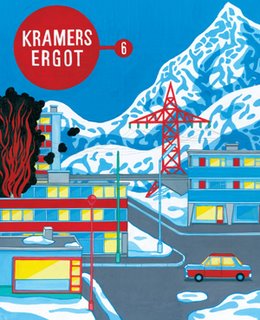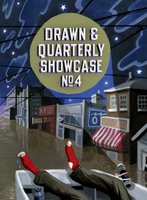Graphic Lit: Kramer's Ergot

Every decade has its definitive comics anthology — a regular (or semi-regular) collection of work that defines the cutting edge for that particular era.
In the ’60s it was “Zap Comix.”
In the ’70s it was “Arcade.”
In the ’80s it was “Raw” and “Weirdo.”
In the ’90s ... well, let’s skip the ’90s for now, OK?
Now, in the dawn of the 21st century, there is again an anthology series that stands head and shoulders above its brethren: “Kramers Ergot.”
The oddly-named treasury has become the go-to book for discovering avant-garde work from up-and-coming or little-known cartoonists.
The latest volume, number six, is in stores and, as with the previous compendiums, it’s a whopper of a book, both in terms of size and aesthetic merits.
At 300-plus pages, “Kramers” features a dizzying array of different artistic styles and methods. Straight, easy-to-follow narratives bump up against surreal, formalist experiments. Obsessively detailed art follows minimalist, almost childish, sketches. Disturbing, apocalyptic tales follow heartfelt, slice-of-life stories.
Somehow, editor Sammy Harkham keeps the book from feeling schizophrenic. Despite the jarring contrasts in style, the stories flow one from the other naturally.
There is an abundance of riches to be discovered, but special mention should be made of the stories by the late Mark Smeets and Suiho Tagawa, two cartoonists, rarely, if ever, seen by Western eyes.
Smeets’ work is typified by cartoonish characters parading through the Dutch countryside, complete with crumbling castles. The individual panels don’t make a lot of sense, but there is a melancholy beauty there that is hard to shake.
Tagawa, on the other hand, made his comics in pre-WWII era Japan, and his work is filled with disturbing propaganda. Armies of cartoon dogs take arms against slow-witted Chinese pigs, with phrases like “It would be an honor to be shot” thrown out every other panel. It’s simultaneously a stunning and unsettling work.
But watching cute doggies do battle shouldn’t be your only reason for reading “Kramers.” It’s chock full of impressive work from people you likely haven’t been exposed to yet. Boost your hip quotient and pick up a copy today.
Other anthologies
"Kramers” isn’t the only recent anthology of note. Here are a few other collections that have hit stores recently:
"An Anthology of Graphic Fiction, Cartoons and True Stories”
edited by Ivan Brunetti
Yale University Press, 400 pages, $28.

Brunetti (best known for his self-loathing comic “Schizo”) has compiled an impressive “greatest hits” collection. Just about every significant cartoonist from the past 30 years and then some can be found here, from Art Spiegelman and Robert Crumb to Lynda Barry and Mat Brinkman.
There’s little here that’s unfamiliar to the devoted comics fan — I think there were about three stories I hadn’t read before — but it’s a perfect book for a neophyte. If someone were to come up to me and ask what the deal was about all this graphic novel stuff, I’d hand him a copy of this book.
“The Best American Comics 2006”
edited by Harvey Pekar and Anne Elizabeth Moore
Houghton Mifflin, 320 pages, $22.

As nice as it is to see Houghton Mifflin extend their “Best” series to comics, if I were in a cranky mood, I would probably quibble over some of the selections. Not because there's anything bad here, but just because there’s other work I would rate higher. That being said, all of the stories found here are of the “very good” to “excellent” quality. And any book that gives Jessica Dart’s “Rabbithead” and Jesse Reklaw’s “Thirteen Cats of My Childhood” a shot at a wider audience deserves to be praised to the skies.
“Project: Romantic”

AdHouse Books, edited by Chris Pitzer
256 pages, $19.95.
Ah, here’s some new material. This is the third in Pitzer’s “Project” series, and, as the title suggests, focuses on romance and love. Usually, themed anthologies fall flat on their face, but Pitzer has a knack for getting the most out of his contributors, or at least selecting A-list material. It’s a shame this is the last in the series. I wouldn’t mind seeing more.
“Drawn and Quarterly Showcase No. 4,”
Drawn and Quarterly, 102 pages, $14.95.

Gabrielle Bell, Martin Cendreda and Dan Zettwoch contribute to this annual anthology devoted to (relatively) new cartoonists. Bell and Zettwoch’s contributions are the stand-outs here. Bell’s story in particular, involving an insecure art student who attempts to teach the son of a famous sculptor, is the best thing she’s done yet and well worth the price of admission.
Copyright The Patriot-News, 2006

0 Comments:
Post a Comment
<< Home